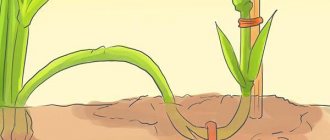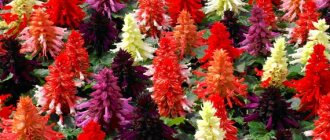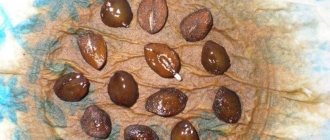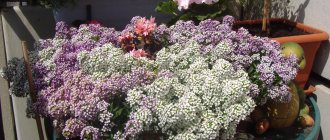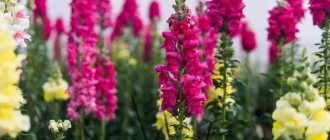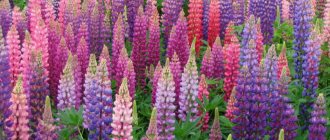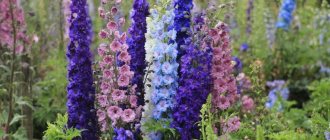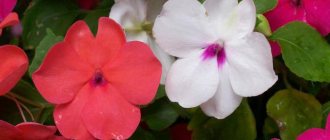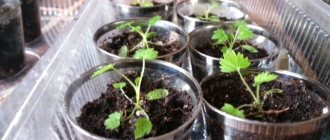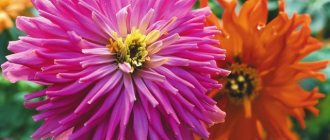Author: Natalya Category: Houseplants Published: February 16, 2019Republished: February 17, 2019Last edits: January 11, 2021
- Growing from seeds
- Why does geranium turn yellow?
- Geranium ivy, or thyroid
Did you know that at home you can grow geraniums with flowers of different shades and even scents? Grafting geraniums is an excellent chance to feel like, if not a breeder, then at least an entertaining gardener. Only young and healthy pelargoniums should be vaccinated. The ideal time to experiment with geraniums is spring. As a base, we take any strong pelargonium older than one year. We cut off the top of a strong stem and make a cut in it with a “tick” of about 2 cm. We insert the prepared scion cutting there, trying to adjust it so that the sections of the rootstock and scion are in close contact. We bandage it with a piece of polyethylene or carefully fix it with a soft woolen thread, and press the bag on top. Within a week it will be clear whether our graft has taken root. Shall we try? More useful techniques and tips for growing pelargonium can be found in our material.
What are the similarities between pelargonium and geranium
Their main similarity is that both plants belong to the Geraniaceae family. And they are similar in appearance. The shape of the seed pod resembles the elongated beak of a crane in both species. Their erect stems and leaves covered with small glandular hairs, arranged oppositely or alternately, are also similar. Both plants have a characteristic specific smell, bright appearance, and are medicinal. They are unpretentious, resilient, love good lighting, and are easy to grow and propagate.
Trimming
Pelargonium - pruning for lush flowering
It is recommended to prune geranium in the fall, shortly before the onset of frost. When the flowers dry out and the formation of new flower buds has finished, it is time for autumn pruning, which will help the plant survive the winter more easily. All wilted flowers and damaged leaves are removed. Elongated stems and weak branches are shortened, spoiling the appearance of the flower. The plant is cut back by about a third. The branch is always shortened above the node, leaving a distance of about 1 cm between the cut and the node.
Related article:
How to dig up and store bulbs of tulips, hyacinths, daffodils, and crocuses
What is the difference between pelargonium and geranium
No one has been able to cross these plants with each other and get seeds - they have different genetic characteristics. Pelargonium is a newcomer from the African savannas, and geranium is native to the northern hemisphere. Therefore, heat-loving pelargonium prefers warm apartment window sills, and geranium blooms in gardens and meadows until frost. In central Russia, geranium, meadow and forest, is found everywhere and calmly endures winter without shelter. Only in the Far Eastern and northern regions does it not grow - the climatic conditions there are too harsh for it. Geranium flowers have 5 or, less commonly, 8 petals. Geranium flowers are regular in shape. The domestic geranium, pelargonium, has five-petalled flowers of irregular shape: the upper two petals are separated from the lower three and are slightly larger than them. Geranium flowers are usually solitary, but sometimes collected in inflorescences. Geraniums have ten developed fertile stamens. Pelargonium flowers are collected in spectacular umbrella inflorescences. Pelargonium has no more than seven fertile stamens. The rest are underdeveloped. Geranium flowers are painted in a wide variety of shades, often blue-violet. Only scarlet color is never found in geraniums. Pelargonium, on the contrary, does not have blue flowers. They are usually white, red and soft pink. Geranium can be found in every garden - summer residents love it very much. Popular varieties of geranium: Magnificent, Georgian, Oxford. It blooms from early summer until frost. And pelargonium pleases with its flowering at home almost all year round. In summer, it can be taken out onto the balcony or even into the garden. But with the onset of cold weather, pelargonium is returned to the house on a warm windowsill.
Names and photos of species and varieties, conditions of their maintenance
Gourmet
This species actively releases essential substances and phytoncides , which destroy a number of bacteria and also have a calming effect on the human nervous system. In addition, essential oil is extracted from it. Basic care requirements.
Curly
Caring for this variety at home is almost identical to caring for the zonal variety, despite the fact that ampelous geranium is more capricious. It reacts more sharply to heat, tolerates dampness very poorly and tolerates dry air very well. It needs little feeding. Transshipment must be done every two years.
Terry
To grow this variety at home, you need moderate air humidity, comfortable temperatures and monthly fertilizing (from spring to autumn) with liquid fertilizers. Should be protected from direct sunlight . It readily propagates by cuttings (you can read about how to propagate geranium by cuttings and dividing a bush here).
Dwarf
This beautiful baby, obtained as a result of selection work, does not require molding pruning, has a pleasant aroma and healing properties, and blooms very beautifully. However, more than others, it needs good lighting (including artificial), moderate temperature (+17-23 degrees) and frequent loosening of the soil after each watering. It is better not to use nitrogen-containing fertilizers, otherwise the buds will form very slowly.
Decorative
This cute variegated flower loves fresh air, so it should be taken out into the garden or onto the balcony as often as possible . Overwintering requires coolness and peace, otherwise later it will refuse to bloom and begin to lose leaves.
Fertilizers with a high content of potassium and phosphorus are purchased as fertilizer. But fresh organic fertilizers are excluded. The frequency of fertilization is 2 times a month from March to October.
Reference! Liquid fertilizer cannot be added to a pot with dry soil - it burns the roots and the plant quickly dies. You need to water the flower first.
Tsarskaya
Aristocrat among other types: the most capricious and pampered. It will delight its owner with its first flowers only in the second year of growth. It does not tolerate either dry soil or waterlogging; it can get sick from the slightest draft and get burned from direct rays of the sun. Therefore, caring for it requires maximum care from the grower.
Royal geraniums cannot accumulate sunlight like zonal varieties , so the light deficit must be regularly replenished. The purchase of additional fluorescent lamps is mandatory, and they need to be illuminated not only during the wintering period, but also on other cloudy days.
- Comfortable temperature:
- for spring-summer - up to 24 degrees;
- in winter it feels great at +12-15 degrees.
- Watering:
- in summer - regular but moderate;
in winter - rare and gentle.
- Propagated by seeds (spring) and cuttings (late summer - early autumn).
- It can be replanted every two to three years into a new ceramic pot. For active flowering and rapid growth, it is recommended to pinch the tops (up to 2 cm).
Water should be poured into a tray - this way there is less risk of damaging the buds.
The most favorite varieties of pelargonium
Pelargonium fragrant
Fragrant is a lush bush with small leaves and bright flowers. Gives off a pleasant aroma of lemon or mint. Less common is fragrant pelargonium with the scent of nutmeg, orange or apple. However, the flowers are inconspicuous, and the leaves are rough and flat. Essential oils and aromatic substances for cooking are isolated from them. The leaves themselves are not used for food!
Pelargonium royal
Royal is a unique bush with a short stem, large flowers and jagged leaves without a zonal pattern. It blooms with very beautiful flowers, but not for long. This group of pelargoniums was bred in the 60s of the last century.
Pelargonium angel
Angel is a hybrid of the curly variety, part of the royal pelargonium group. Similar to the royal one, but smaller, more compact, with small leaves and flowers similar to pansies.
Pelargonium ampelous
Ampelous or ivy-leaved - this pelargonium has thin stems and an ampelous growth pattern. Its leaves are similar to ivy, and its flowers are simple, double, and even in the form of rosettes.
Pelargonium zonal
Zonal - this bush has a developed, upright growing stem and dark circles on the leaves that divide the leaf plate into multi-colored zones. Flowers can be simple or double. They are not large, collected in inflorescences-umbrellas of white, red or pale pink. Many people call this pelargonium geranium.
The features of caring for geraniums and pelargonium differ no more than caring for a garden plant from caring for a houseplant.
We will look at growing indoor geraniums - pelargonium. How long the external attractiveness of the plant will remain depends only on the care of its owner, and the lush and bright inflorescences of pelargonium will decorate the interior of your apartment. When kept at home, decorative varieties of pelargonium retain their spectacular appearance for at least five years. But there were cases when pelargonium lived and bloomed for ten or more years with good owners. We will introduce you to simple conditions under which your pet will delight you with its beauty for a long time and improve your health.
Varieties
There are more than 400 varieties of geraniums. Here are the most popular varieties:
Related article:
Work in the flower garden in August
Pelargonium grandiflorum
- Pelargonium grandiflorum - better known as English geranium or noble geranium. This is a showy shrub with successively arranged fleshy stems, green leaves, and asymmetrical, variegated flowers. There are many hybrids of different shades. It is more capricious and difficult to grow than other geraniums.
Pelargonium graveolens or scented geranium
- Pelargonium Graveolens - also called fragrant geranium. There are different representatives with the aroma of mint, rose, lemon, and spices. Typically blooms in summer.
Pelargonium domesticum
- Pelargonium domesticum is a common type of geranium for indoor growing.
Pelargonium ivy-leaved
- Pelargonium ivy-leaved is among the little-known species that form hanging shoots. They have star-shaped leaves that are dark green in color and resemble ivy leaves.
Reproduction of indoor pelargonium
Homemade geranium, i.e. Pelargonium is propagated by seeds and vegetatively.
Cuttings
This is the easiest and fastest way - using cuttings. In addition, the characteristics of the mother plant are completely preserved, and the first flowering already occurs in the first summer after rooting. Cut cuttings from the tops of an adult plant, 7-10 cm long, with four to five leaves. Make a cut under the bud diagonally. Tear off the bottom pair of leaves. Let the cuttings lie in the air for two to three hours so that the cuts dry out and become covered with a film. Sprinkle them with crushed activated carbon and plant them in a prepared, slightly damp substrate. Don't cover it with anything. Place the pots in a well-lit place, but not in the sun! Do not water for 24 hours. The next day, start watering very carefully, drop by drop, to prevent the shoots from rotting. In a month, good roots should appear. Young pelargonium can be transplanted into a permanent pot and cared for like other plants. To make the bush grow lush, pinch at the growing point at the top.
Sometimes the cuttings are placed in a glass of standing warm water. With this method, rotting of cuttings occurs more often. We recommend adding an activated carbon tablet to the water. And reserve a larger number of cuttings for rooting at once, in case they die.
If your pelargonium has grown too tall over the winter, leave only part of the trunk with the lower young rosettes in the pot, and cut off the rest and use it for propagation. We have already described above how to root the tops of shoots. Cut the middle of the trunk into pieces so that each has several buds. Roots will grow from the lower buds, and shoots with leaves will come from the upper ones. Root parts of an adult healthy trunk cut into a piece in the same way: dry it, treat the cut with crushed coal, it wouldn’t hurt to dip it in Kornevin powder, then plant it in the ground. Do not flood young plantings - they need to breathe. In early spring, the survival rate of cuttings is almost 100%.
Propagation by seeds
It is believed that pelargonium grown from seeds grows more luxuriantly and blooms much better than those grown from cuttings. May be. But this method is more complex and time-consuming. Buy seeds from special, trusted stores. Sowing time is January or February. Place the seeds on a slightly damp surface of the substrate in a container and close the lid. You can use another container, then cover it with film or glass. Place in a warm, dark place. The temperature should be between 20 - 25 degrees. In a week or two the first shoots should appear. Move the container or other container with the seedlings to a bright place. Open the container lid slightly to ventilate the greenhouse and remove any condensation that has accumulated there. When two true leaves appear on the seedlings, they need to be picked. It is advisable to reduce the further temperature to 16 - 18 degrees. After a couple of months, the grown pelargoniums can be planted in small pots and you can begin to care for them like adult plants.
Dividing the bush
Sometimes an adult plant is propagated by dividing the bush into two approximately equal parts. To do this, remove the plant from the pot. Shake the soil from the roots. Carefully straighten and distribute the root system into two parts. Using a sharp, clean knife, divide the bush into two parts. The sections must be sprinkled with crushed charcoal or activated carbon. Each part of pelargonium is planted in its own pot according to all the rules for successful planting. Healthy, strong plants will quickly restore their shape and bloom the same summer.
Maintenance in winter
Home geraniums do not have a pronounced dormant period. It does not shed its leaves, but drinks less water and rarely blooms. During this period, it is advisable to water it less. Once every 10 days is enough. And don't feed it. You will begin to fertilize in the spring with complex fertilizers containing nitrogen, and in the summer with potassium-phosphorus fertilizers. But, just a little. It is also advisable to reduce the temperature to 20 degrees. during the day. Below 12 deg. It’s better not to lower the temperature at all, even at night. It is good to place the flower pot on a cold windowsill - the coolness from the window glass will be enough for a quiet winter life for home pelargonium.
This may be interesting: Popular types and varieties of indoor Koleria (Kaleria)
general characteristics
Pelargonium is a perennial herbaceous plant. The name of the family remains the same: Geraniaceae. Although over time, botanists identified the genus “Pelargonium” separately.
It is almost impossible to identify common features for a family that has five genera and hundreds of species. There are herbaceous, creeping, straight, branched varieties, and there are shrubs. Flowers vary in shape and size, but are most often collected in umbrellas. Leaves are regular, palmate or dissected. The fruit is a capsule with sepals.
Thanks to its southern origin, pelargonium easily tolerates sun, heat and dryness. But she is not ready to winter in open ground.
Diseases
Blackleg
If the base of the stem turns black, it begins to rot - your pelargonium has become infected with a disease that is terrible for indoor flowers - black leg. Most likely, you allowed the soil to become waterlogged and the plant’s root system to become overcooled. We are sorry, but pelargonium cannot be saved. The bush must be destroyed along with the soil. The pot can be disinfected and used again.
Gray mold
Gray mold appeared on the leaves of pelargonium in the form of plaque or cobwebs. There are dark spots on the stems. This happens with excessive watering when the soil does not dry out well. Roots suffer without air. You most likely have heavy soil or poor drainage. Therefore, pelargonium developed a disease - gray mold. It is caused by fungi and is therefore treated with antifungal drugs - fungicides.
Leaf rust
Small yellow-red spots appeared on the leaves of pelargonium, which eventually turned into stripes. The leaves turned yellow, dried out and fell off. Leaf rust is a fungal disease. It appeared due to high humidity in the room, uneven and irregular watering. But perhaps the fungi came to you from contaminated soil. Remove leaves and shoots affected by rust. Spray the flower 2 - 3 times with a break of 10 days with fungicides such as oksikhom, Abiga Peak and others.
Biological products, such as phytosporin, do not treat rust!
Powdery mildew
Mealy spots appeared on the leaves of pelargonium and on its flowers. They are easy to remove, but they appear again and again, enlarge, become gray, dense, and then turn brown. The leaves dry up, the flowers fall off. The plant stops developing. Your room may have very high humidity and heat. You may have overfed your pelargonium with nitrogen fertilizers. Instead of blooming more profusely, the flower became sick with powdery mildew. Regularly ventilate the room, do not spray the plants, do not feed them with fertilizers containing nitrogen additives. Spray the flower with a solution of water with milk and iodine or fungicides such as topaz or oxych.
Other problems with home geraniums
Other problems of home geranium, why the leaves turn yellow and what to do in this case:
- If your pelargonium leaves turn yellow and dry, especially the lower ones, there is not enough moisture in the soil. Increase watering, after which always loosen the soil. Remove yellowed leaves by hand, do not use scissors.
- If the leaves at the top of the bush become wet and loose, you are watering your flowers too often and abundantly. Adjust watering and drain excess water from the pan. Water when the top layer of soil is slightly dry.
- If the leaves of the pelargonium turn red and it suddenly stops blooming, it is most likely a cold snap and the plant froze. Move it to a warm place and everything will be fine.
- If a pink tan from sunlight appears on the leaves of flowering pelargonium, this is a normal phenomenon, common for summer growing in flower beds.
- If the leaves of the pelargonium begin to fly off and the lower part of the trunk is exposed, the pot is probably in a dark place. The plant does not have enough lighting. Move it to a sunny windowsill, and the bush will grow again and begin to bloom.
- If pelargonium is actively growing, does not get sick, there are no pests, but does not bloom, then the reason most likely lies in the air temperature surrounding the flower being too high. Pelargonium is thermophilic, but it is difficult for it to be constantly in 30-degree heat. Pelargonium refuses to bloom indoors at high temperatures. Take it out into the fresh air - onto a balcony or veranda - we are sure it will bloom there.
- Another reason for failure to flower may be too large a pot or too much nitrogen fertilizer in the soil. Pelargonium fattens, increases the mass of green leaves to the detriment of flowering. Remove the bush from the pot, carefully shake off the soil, and inspect the root system. Now select a pot according to the size of the plant’s root system. Do not forget about good drainage, loose soil in which you will plant your flower again. Water moderately but regularly. Place in a well-lit place. After some time, pelargonium will definitely bloom.
How to grow geranium from seeds
Growing geraniums from seeds photo seedlings
- Seeds are sown in bulk on the nutrient mixture as little as possible, sprinkled with a thin layer of earth or sand on top.
- Pots for seedlings are chosen small in size, 50-100 ml.
- After planting, the container is covered with film to create a greenhouse effect that helps the seeds germinate as quickly as possible.
- Every day it is necessary to remove accumulated condensation from the film so as not to provoke the development of fungal diseases.
- When the first shoots appear, the film is removed.
- Watering is carried out as needed, without waterlogging the soil.
- After 2-3 true leaves appear, the bushes are planted in containers for continuous growth.
- Seedlings must receive a lot of light so that development occurs fully, the plants do not stretch out and do not get sick.
The video will tell you more about growing geraniums from seeds:
It’s not a difficult task, so even novice flower growers and schoolchildren can handle it. By the way, children really like to participate in the process of growing seedlings. Then they watch with delight as the plants develop, release their first buds and delight with abundant flowering.
Pests
The leaves of homemade geranium emit a specific aroma that many pests do not really like. Pelargonium is even placed closer to indoor plants that are susceptible to parasite attacks. But, nevertheless, it is possible that some pests may appear on pelargonium, which are not afraid of its smell, for example, whiteflies or spider mites. It is necessary to periodically inspect the plant for damage by sucking parasites and take action if they are found (you will have to spray it several times with folk remedies or insecticides).
Medicinal properties
Since ancient times, people have been treated with indoor plants, specially growing those that were most suitable for them for medicinal purposes. Pelargonium has many magical properties. Flower pots with geraniums often decorated the window sills in our grandmothers' bedrooms and kitchens. The aroma of pelargonium has been proven to help relieve headaches and stress. At the same time, ants and flies do not like their smell. Decoctions of the leaves are used to treat gastrointestinal tract and nervous disorders in people. They are drunk during insomnia. In addition, they treat joint pain, conjunctivitis, hypertension and much more. But there are also contraindications - consult your doctor before prescribing this or that treatment for yourself.
Since ancient times, pelargonium (before everyone called it geranium) has been grown in every family. It was believed that she protected the house from damage and the evil eye, protected the family from conflicts and quarrels, and contributed to the material well-being of its owners. Where flowering geraniums grow, love and harmony live there! Who knows?! But just because this abundantly flowering plant is so attractive and completely unpretentious - it’s worth having it at home!
